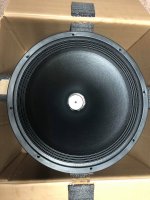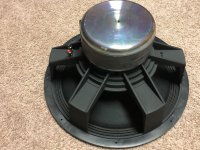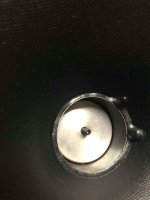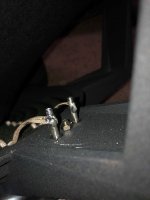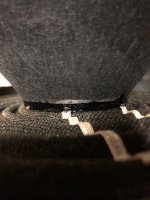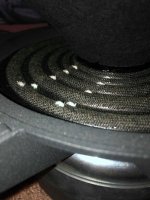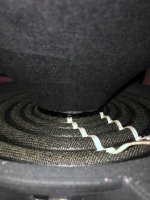Pano, could you elaborate how fragile the "separate space" effect is? Has it been perceivable in certain sweetspot only or is the effect immediately apparent when you walk into the room while such system is playing?
I think that this is the epitome of imaging and is the effect of getting excellent phase and delay synchronization between the set of loudspeakers and the listener in the sweet spot. Finally the results not being dismantled by the room....and yes it is a sweet spot thing, even wide dispersion speakers perform best either at 0 degrees or within some particular window.
I should also say that I don't think that the above are the end all, I just think that when you have a system with the transient ability, preferable voicing... or should I say generally speaking, great sonic ability...its the alignment of the phase and delay that truly bring it all into focus, at the sweet spot, in particular.
I should also say that I don't think that the above are the end all, I just think that when you have a system with the transient ability, preferable voicing... or should I say generally speaking, great sonic ability...its the alignment of the phase and delay that truly bring it all into focus, at the sweet spot, in particular.
Last edited:
I fully agree with that......phase and delay is how I can focus the effect.
Near as I can tell the sweet spot as far as this effect is 2-3 feet wide/1-2 feet tall on my system. (10” 2-way pro mid-woof / inverted dome tweeters...2x10” subs) So it’s definately not whole room but not head in a vice either (it still sounds good outside the sweet spot though).
Near as I can tell the sweet spot as far as this effect is 2-3 feet wide/1-2 feet tall on my system. (10” 2-way pro mid-woof / inverted dome tweeters...2x10” subs) So it’s definately not whole room but not head in a vice either (it still sounds good outside the sweet spot though).
^ Yes it is one of the points.
I have something to say about nearfield, yes it is fine and you could very well have what Pano describe this way too but... a mid/ far field listening position in big room bring something which is usually tactileness of bass and low mid. Courtesy of large membrane area. Even better outside with some kind of music.
I think i've heard the thing Pano describe maybe 3 to 4 times. Two of them was with ( very big) PA for edm events. The things with this system was they were designed to a specific genre in mind. Even played on once a dj set ( drum & bass). Unforgetable moment. No modes is a pure joy for bass heavy/ difficult electronic music.
I have something to say about nearfield, yes it is fine and you could very well have what Pano describe this way too but... a mid/ far field listening position in big room bring something which is usually tactileness of bass and low mid. Courtesy of large membrane area. Even better outside with some kind of music.
I think i've heard the thing Pano describe maybe 3 to 4 times. Two of them was with ( very big) PA for edm events. The things with this system was they were designed to a specific genre in mind. Even played on once a dj set ( drum & bass). Unforgetable moment. No modes is a pure joy for bass heavy/ difficult electronic music.
Last edited:
Tough question; I probably didn't pay attention to that. I don't remember it being particularly focused, but can't say with accuracy. Sorry.Pano, could you elaborate how fragile the "separate space" effect is?
Thanks, kind of wanted to know if such rare thing can be missed while tuning a system by not having head in the right spot, or is it already tingling the brain when approaching the system state for the effect to appear.
Mountainman bob, have you listened your system with mono signal, only one speaker playing, if it still has some of the qualities as stereo system in regards of this effect?
Currently evaluating mono prototype and I'm wondering if the effect is somewhat eachievable in mono, gotta stop tweaking at somepoint and build a pair 🙂
Mountainman bob, have you listened your system with mono signal, only one speaker playing, if it still has some of the qualities as stereo system in regards of this effect?
Currently evaluating mono prototype and I'm wondering if the effect is somewhat eachievable in mono, gotta stop tweaking at somepoint and build a pair 🙂
This is a fundamental misunderstanding from those who have not heard extraordinary systems. The "I want bad recordings to sound bad" trope is common and quite understandable - if you haven't heard what can be done. I know that comes across as condescending, but it is not meant to be. Extraordinary systems are rare, but definition. I've heard them, but only come close to owning one after many years of effort.
Pano, I can fully agree with the above, but only in the short term. Will explain shortly....
I do believe I've heard a number of extraordinary systems....more than a few over the years.
And I think I have some remarkable systems right now...sometimes I just burst out laughing, want to bite my knuckles, from sheer listening pleasure.
By 'only in the short term', I mean whenever I hear a system that sounds new and better than anything I've ever heard, I eagerly go back and play many many old favorites to see what they sound like. I'll wager many of us do that. 🙂
And yes, often recordings that I didn't think were all that good, sound better. (Of course, this luxury of playing back many songs doesn't exist when the system isn't ours..so usually that just means memory of a great system with further verification.)
But I find over time, that my ears become accustomed to the new higher level of excellence, and start discerning between good and bad recordings just like before. A never ending quest i guess......
What defines good and bad ?? For me, pleasure ...and if not fully pleased I usually know within seconds of listening what I'd like to change about the song or the system I'm listening to.
I guess this comes from mixing live, where we have some real control on the sound. Dunno, but I do know I've always wanted a programmable EQ that brings up saved settings for each song.
Anyway, as much as I'd like to believe a truly great system exists that can make all recordings sound good....I just flat can't...there's simply too much 'horses for courses going on', in terms of how a recording was made and what kind of system best mirrors its reproduction.
Thanks, kind of wanted to know if such rare thing can be missed while tuning a system by not having head in the right spot, or is it already tingling the brain when approaching the system state for the effect to appear.
Mountainman bob, have you listened your system with mono signal, only one speaker playing, if it still has some of the qualities as stereo system in regards of this effect?
🙂
For me i can tell when the system is dialed (in or not) outside the sweet spot,even from another room (there is a relaxed air about it) but......the full effect (in my case,I’m sure it will differ with speaker type/room) only exists in that 3’w x 2’h area.
With mono I’ve never tried only one speaker but with a quality mono recording
It does indeed do the same thing.....in fact I’ve never heard such depth and separation on mono recordings before.
Mark......it really does work across the board, it’s just better on really good recordings. Vocals....especially female come across in a ghostly hair raisingly smooth way.
Last edited:
Yup, the small AMTs are (were?) populair for small desktop monitor speakers. I've heard many of those and liked the Adams quite a bit.
A (Steinway) Mungdorf room corrected setup does have its merits: in home theatres.
In the French thread someone referred to the Dutch Stage Accompany speakers with the planar mid-high unit (SA8535).
Its predecessor, the SA8520, was originally co-developed with Philips in the early 80s.
Later, a number of former SA people founded Alcons Audio
I think Beyma took inspiration from the SA/Alcons drivers in development of the TPL range.
An externally hosted image should be here but it was not working when we last tested it.
This is not related to the topic of the thread, but could I ask which forum this is? Sounds like an interesting forum, and it would also be a way for me to brush up on my French. Merci 🙂
1. It's 2-way and so on))This is not related to the topic of the thread, but could I ask
2. Google Search
Pano, I can fully agree with the above, but only in the short term. Will explain shortly....
I do believe I've heard a number of extraordinary systems....more than a few over the years.
And I think I have some remarkable systems right now...sometimes I just burst out laughing, want to bite my knuckles, from sheer listening pleasure.
By 'only in the short term', I mean whenever I hear a system that sounds new and better than anything I've ever heard, I eagerly go back and play many many old favorites to see what they sound like. I'll wager many of us do that. 🙂
And yes, often recordings that I didn't think were all that good, sound better. (Of course, this luxury of playing back many songs doesn't exist when the system isn't ours..so usually that just means memory of a great system with further verification.)
But I find over time, that my ears become accustomed to the new higher level of excellence, and start discerning between good and bad recordings just like before. A never ending quest i guess......
What defines good and bad ?? For me, pleasure ...and if not fully pleased I usually know within seconds of listening what I'd like to change about the song or the system I'm listening to.
I guess this comes from mixing live, where we have some real control on the sound. Dunno, but I do know I've always wanted a programmable EQ that brings up saved settings for each song.
Anyway, as much as I'd like to believe a truly great system exists that can make all recordings sound good....I just flat can't...there's simply too much 'horses for courses going on', in terms of how a recording was made and what kind of system best mirrors its reproduction.
For sure when I first started using software to correct phase and eq, I was blown away....I thought, wow, here I am wondering what will be the next system to invest in, when in actuality, I've never really heard the system I have. What I was hearing after calibration was life changing, being the first time I heard what could be improved via software/dsp. I went through a numerous amount of Bjork tracks, but then I found myself on youtube, listening to stuff like 90's Madonna, stuff that I find commercial and slightly corny, had me tapping my foot lol! Madonna isn't a go to for me either way but because I could hear a clearer picture of the studio engineering, it moved me from an engineering stand point.
- I don't think Pano was suggesting that a sublime system makes the recording sound better, in that sense. Its just better in the terms of resolution, which our ears appreciate regardless of how well the record has been produced. There is a confusion of perspective and approach. The mix engineer hears too much attack or not enough attack on the snare. The loud speaker engineer hears speed and coherency of the snare reproduction via driver and system, regardless of the studio engineer jargon that he/she may or may not know. See what I mean? The studio engineer hears the work of the actual manipulation of studio tools upon the signal where as the the loudspeaker engineer is hearing how well the system is actually producing the signal its being sent. From the the loudspeaker engineers standpoint, with a highly sublime system, everything sounds better, too which it really does. From the Studio engineers perspective, one whos been trained to decipher whats bad and good is, on a slightly subjective scale, no system is going to compensate for a bad recording, unless its hiding something due to unique frequency response, limited bandwidth, etc. etc. The tight rope is actually knowing what source material is actually one to be gawked at. I think a person with a strong background in live music has an advantage hear.Anyway, as much as I'd like to believe a truly great system exists that can make all recordings sound good....I just flat can't...there's simply too much 'horses for courses going on
A bad picture (bad mix) with a blur effect (mastering glue?) viewed in 640x480 (bad system)... Take that same picture and render it in 4k, and the blur becomes so well defined that, you can tell whats behind the blur (mastering glue) is a bad painting (definition within the mastering) but the resolution of the blur and painting is now so incredibly detailed that to you (Designer of computer displays? lol) the rendering, has become art itself, and you aren't looking at the picture anymore but blown away by how highly intricate the resolution of the blur is.....The artist on the other hand, can tell on the first system that things are wrong, and then on the second system he can tell that something is wrong, and see what exactly those items are through the fog....where as most studio engineers have a varying degree of Technician and Artist, inside them, so our emotions can be pulled either way sense we see both, but as mark put it, its in the "short term". Which subjective depending on if you look at it as being married to a system for some years, or having listened to sub par systems for the better part of day and then coming home to your beautifully tuned system. As said "over time...ears become accustomed to the new higher level of excellence, and start discerning between good and bad recordings just like before".
Last edited:
^They recorded in real rooms, with real musicians playing together and minimalist setup.
The gear was full of flaws (distortion amongst other) and limited so was the temptation to f.ck up things.
This techniques was adapted to the source material too.
But most of all, the records were made after a group or an artist toured for many month.
The arrangement were usually very good too.
The gear was full of flaws (distortion amongst other) and limited so was the temptation to f.ck up things.
This techniques was adapted to the source material too.
But most of all, the records were made after a group or an artist toured for many month.
The arrangement were usually very good too.
YouTube
"the thing that strike you is the honesty of it" - I wonder what he means by honesty...the options are somewhat limiting when it comes to manipulation but thats not exactly the most honest answer. I think we were talking about about where the "magic" is sourced in this production line, that is audio.....I think that a person has been neglected to be mention'd. The recording engineer! In a studio with limited processes like in the 50's, your recording engineer is the most influential in the chain, and if we are talking about recording live audio, that remains true. A bad recording can not be absolutely fixed by the mix or mastering engineer, just dressed up or hidden. Outside of that, is the pressure to actually perform the material in a way that once recorded is worth listening to again.
So now, set that aside, and realize that today, most of the VST plugins emulate or at least try to emulate the same hardware that was used in the retro...is used in production today, whether a VST or an actual hardware clone... there is something here. Transducers, Capacitors, Valves, Tubes, Transistors, etc...these innards that were used to construct the old hardware introduce odd and/or even order distortion, uniquely to the piece of hardware, that are harmonic in nature. Eq, compressors, limiters, preamps, etc....every time the signal runs through, even/odd order distortion increases in a certain color, unique to that hardware. We find this pleasurable to our ears, it makes the signal fatter, thicker, and interesting. This generation, balance and manipulation of harmonic content is in essence, the mastery of creating good mixes and masters. "All" the studio guys know this, but as a loudspeaker designer, what does this mean to you?
"the thing that strike you is the honesty of it" - I wonder what he means by honesty...the options are somewhat limiting when it comes to manipulation but thats not exactly the most honest answer. I think we were talking about about where the "magic" is sourced in this production line, that is audio.....I think that a person has been neglected to be mention'd. The recording engineer! In a studio with limited processes like in the 50's, your recording engineer is the most influential in the chain, and if we are talking about recording live audio, that remains true. A bad recording can not be absolutely fixed by the mix or mastering engineer, just dressed up or hidden. Outside of that, is the pressure to actually perform the material in a way that once recorded is worth listening to again.
So now, set that aside, and realize that today, most of the VST plugins emulate or at least try to emulate the same hardware that was used in the retro...is used in production today, whether a VST or an actual hardware clone... there is something here. Transducers, Capacitors, Valves, Tubes, Transistors, etc...these innards that were used to construct the old hardware introduce odd and/or even order distortion, uniquely to the piece of hardware, that are harmonic in nature. Eq, compressors, limiters, preamps, etc....every time the signal runs through, even/odd order distortion increases in a certain color, unique to that hardware. We find this pleasurable to our ears, it makes the signal fatter, thicker, and interesting. This generation, balance and manipulation of harmonic content is in essence, the mastery of creating good mixes and masters. "All" the studio guys know this, but as a loudspeaker designer, what does this mean to you?
Last edited:
having been involved (from a young age) with many different aspects of live music amplified or not, live recording,studio recording,mastering, live sound reinforcement, etc... all really helped when I delved into speaker design a couple years ago.
knowing what different things 'should' sound like really helps.
knowing what different things 'should' sound like really helps.
This generation, balance and manipulation of harmonic content is in essence, the mastery of creating good mixes and masters. "All" the studio guys know this, but as a loudspeaker designer, what does this mean to you?
All it can mean since all the various electronics are providing all of the 'tone'; max flat amplitude & phase response [can accurately reproduce a square wave] to the limits of audibility/feeling threshold [~22.63 - 19,483.87 Hz] and a microphone that can accurately capture it [is there one?].
Just as importantly is the ~ 1 - 300 kHz BW the amp needs to accurately reproduce it IIRC [can't remember/find the math ATM].
In short, a ~ 8" single driver [the ~ 664 Hz acoustic power mean between the BW limits] with some pretty incredible specs.
W.E.'s 755 ~ did it to the limits of the recording/playback monitors at adequate SPL/low distortion, but don't see how we can do it down to ~20 Hz, especially at today's [much] louder SPLs.
If we use this as the XO point, then the LF mean requires a ~ 15" and the HF a 2.5 - 3" frame [~1.2" effective diameter], so with a slightly different acoustic mean it's not hard to see why W.E. used a relatively tiny compression loaded driver for such a large horn.
GM
Good points, limited opportunity to screw it up, complex, more modern material is often made a mess of, Zappa being my favourite exception.^They recorded in real rooms, with real musicians playing together and minimalist setup.
The gear was full of flaws (distortion amongst other) and limited so was the temptation to f.ck up things.
This techniques was adapted to the source material too.
But most of all, the records were made after a group or an artist toured for many month.
The arrangement were usually very good too.
- Home
- Loudspeakers
- Multi-Way
- Is it possible to cover the whole spectrum, high SPL, low distortion with a 2-way?
